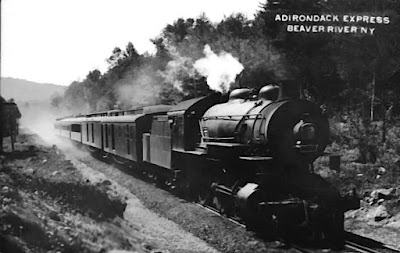The Railroad Changed Everything
Prior to the opening of the railroad in late 1892, it took a minimum of three days of hard travel to reach the upper Beaver River from Lowville, the nearest town with a transportation connection to the rest of the state. Once passenger trains started running, the trip could comfortably be accomplished in just hours from Utica where there were railroad connections to the rest of the nation.
Dr. William Seward Webb, the man who financed the railroad, began to acquire the necessary right-of-way in early 1891. In the Beaver River area, he purchased about 350,000 acres lying between the St. Lawrence County line and the Fulton Chain of Lakes, including most of the land surrounding the upper reaches of the Beaver River.
Dr. Webb only required a small sliver of this property for the railroad. In the short term, he intended to harvest the marketable timber from most of this property. He also planned to set aside 40,000 acres around Smith’s and Albany Lakes to create Nehasane Park, his private great camp and game preserve. In the longer run, as more tourists visited the region, he hoped to sell cottage lots around the scenic lakes.
Throughout 1891 and 1892, even during a very harsh winter, Webb’s contractors cleared the railroad right of way and laid track. The final spike was driven on October 12, 1892, at Twitchell Creek, not far from Stillwater. Scheduled passenger service began on October 24. In eighteen months, eight crews of railroad workers had managed to lay 191 miles of track under extremely difficult conditions. Webb named the completed line the Mohawk & Malone (M&M) Railway. Only a few months later, on April 20, 1893, he leased the M&M tracks to the New York Central. The southern terminal was shifted to Utica and the line was renamed the Adirondack Division of the New York Central Railroad.
Dr. Webb knew how popular the upper Beaver River was with sporting tourists so he directed a train station be built where an old logging tote road crossed the tracks about two and a half miles west of Little Rapids. At the time there were no dwellings or other buildings at the location. His construction crews cleared a few acres, and built a station and some outbuildings. By constructing this station several miles away from his future great camp, he felt the public could be diverted away from his private Nehasane Park.
In anticipation of the need for private land in the vicinity of the new Beaver River station to build a settlement, in 1893 Webb created a square parcel of land exactly six-tenths of a mile on each side, more or less centered on the station. He called this parcel the Beaver River Block. In 1896 when he sold 75,000 acres to the state, he exempted the Beaver River Block from the sale of the surrounding forest. In 1899 he sold the entire Beaver River Block to Firman Ouderkirk, a lumberman who had a sawmill there.
As Webb predicted, the railroad attracted a substantial tourist trade. By 1910, ten passenger trains a day passed through Beaver River Station, although not all of them had scheduled stops. On Friday evenings in the summer months, the overnight sleeper to the Adirondacks would depart from New York City with 300 to 400 passengers.
Outdoor recreation in the upper Beaver River boomed. The local guides refocused their activities from Smith’s Lake to the Chain of Lakes along the Red Horse Creek where new guides’ camps sprang up almost overnight. The Beaver River Club, a private sportsmen’s club at Stillwater, opened in 1893. The Rap-Shaw Club began in 1896, attracting members from all over upstate New York for fishing and hunting. By 1899 a grand Victorian hotel called The Norridgewock was built only a short walk from the train station. Each of these developments will be the subject of its own future post.
Beaver River Station was quite an interesting place in those days. At the railroad station it was possible to encounter people from at least four different social classes. There was the occasional person of great wealth from one of the East Coast cities traveling to or from Dr. Webb’s Nehasane Park. More frequently there would be a well-to-do upstate family traveling to or from the Beaver River Club. The most frequent visitors were upstate professional men of moderate means who stayed at a hotel in or near Beaver River Station or at a camp on the Red Horse Chain. The fourth group was made up of the guides, hotel workers, railroad workers and laborers along with a few sawmill workers and lumberjacks.
Like the sporting tourists who came before them, the people who arrived by train were attracted by the outdoor life centered on fishing and hunting. At first the men came by themselves, but soon their wives and families came too. As the number of visitors increased so did the number of facilities that catered to them. Within only a few years the upper Beaver River began to acquire the first trappings of civilization. Regular mail service and a telephone line connected the station to the outside world. Supplies and fresh groceries arrived daily by train. The old wilderness gradually disappeared, and a new economy based on tourism started to take shape. None of this would have happened without the railroad.
The illustrations for this post are courtesy of the magnificent real photo postcard collection of Frank Carey





Comments
Post a Comment